| Srl | Item |
| 1 |
ID:
080441
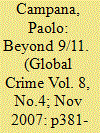

|
|
|
|
|
| Publication |
2007.
|
| Summary/Abstract |
By drawing upon the first results of an analysis carried out on the 1998-2005 period, this work tries to reconstruct the trends in terrorist attacks and their media coverage in seven international daily newspapers. Also the dynamics of media over/under-representation are investigated, as well as the existence of differentiated coverage related to the geopolitical distance/proximity of the country object of attack. Special attention is paid to an empirical analysis of the Iraqi case. The work opens with a short methodological discussion on the issue of terrorism measurement, from its operational definition to the choice of the database on which to carry out the analyses.
|
|
|
|
|
|
|
|
|
|
|
|
|
|
|
|
| 2 |
ID:
080442
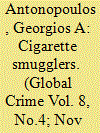

|
|
|
|
|
| Publication |
2007.
|
| Summary/Abstract |
The smuggling of contraband cigarettes is discussed in relation to numerous financial and social issues. Cigarette smugglers are often portrayed as ruthless and dangerous individuals, and according to official and media accounts a clear link has been established between cigarette smuggling and 'criminal and terrorist organisations'. The aim of this article is to challenge this stereotypical image of the cigarette smugglers based on the presentation of the stories of four smugglers interviewed in Greece and the UK
|
|
|
|
|
|
|
|
|
|
|
|
|
|
|
|
| 3 |
ID:
080440
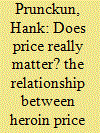

|
|
|
|
|
| Publication |
2007.
|
| Summary/Abstract |
This study determines the relationship between the black market price for heroin and its corresponding purity in Australia for the period from July 1996 to June 2003 (seven years). The study used regression and correlation analyses to test the relationship between the two variables. If a negative relationship was found, then it would suggest that law enforcement operations were effective. However, the study determined that there was a near-zero correlation (r = 0.02) at commercial level (i.e. weights of one ounce) but a moderate relationship (r = 0.37) at user level (i.e. weights of 1 g). From this it was concluded that Australian law enforcement operations targeting commercial quantities were neither effective nor ineffective; but operations targeting street-level users were noticeably ineffective. To improve success at both levels, the study put forward the proposition that more aggressive enforcement operations in front of the international Customs barrier may be needed
|
|
|
|
|
|
|
|
|
|
|
|
|
|
|
|
| 4 |
ID:
080439
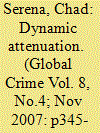

|
|
|
|
|
| Publication |
2007.
|
| Summary/Abstract |
This article analyses the ability of the US Army Special Forces to combat illicit networks (criminal and terrorist) through 'dynamic attenuation'. It is argued that a process of dynamic attenuation, where network ties and not the actors in the network are targeted, should replace the current US strategy of 'killing or capturing' criminal agents threatening US interests. By dynamically attenuating (not destroying) the ties between and among criminal actors and criminal organisations, the US can effectively reduce the capability of criminal organisations to operate and achieve their missions (profit and/or terror). This argument is substantiated by assessing the environments where criminal networks thrive, the characteristics of criminal networks, the utility of targeting networks instead of individual actors, and through a comparison of criminal organisations' and US Army Special Forces' strengths and weaknesses. This article concludes with implications and recommendations for US policy in the fight against criminal organisations
|
|
|
|
|
|
|
|
|
|
|
|
|
|
|
|
| 5 |
ID:
080436


|
|
|
|
|
| Publication |
2007.
|
| Summary/Abstract |
This study estimates that the economic cost of crime in Chile, using the accountancy method, is $1.35 billion as at 2002; that is, this cost is equivalent to 2.06% of Chile's GDP. Crimes included in the estimation are murder, robbery, larceny-theft, burglary, wounding, rape and sexual assaults, domestic violence and economic felonies such as fraud, forgery and so on. Consequential costs are the most important, representing 68% of the total cost of crime. Government spending represents 23% of the total and anticipatory cost account for the remaining 9%. Chile presents higher level of crime than most developed countries - though less than most developing nations - but government's spending on citizen's security is considerably lower than that of the US and several other European countries
|
|
|
|
|
|
|
|
|
|
|
|
|
|
|
|
| 6 |
ID:
080438
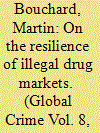

|
|
|
|
|
| Publication |
2007.
|
| Summary/Abstract |
This paper argues that the concept of resilience is a fruitful way of understanding the impact of repressive policies on illegal drug markets. For the purpose of this article, resilience is defined as the ability of market participants to preserve the existing levels of exchanges between buyers and sellers, despite external pressure aimed at disrupting the trade. The first part of the paper highlights how some of the core features of illegal drug markets, a decentralized structure and high prices, contribute to increasing their resilience to attacks. The second part develops a framework that can be used to compare markets on the basis of their resilient properties. Some of the empirical and policy implications of the framework are discussed in the conclusion
|
|
|
|
|
|
|
|
|
|
|
|
|
|
|
|
| 7 |
ID:
080437


|
|
|
|
|
| Publication |
2007.
|
| Summary/Abstract |
This paper employs the modified Wald (MWALD) causality test to re-examine the relationship between crime and its determinants (inflation and unemployment) in the United States from 1960 to 2005. Bounds test approach is employed to investigate the existence of a long-run relationship. The empirical evidence suggests that inflation and crime rates are cointegrated with a positive relationship. Moreover, the causal link is from inflation and unemployment to crime
|
|
|
|
|
|
|
|
|
|
|
|
|
|
|
|